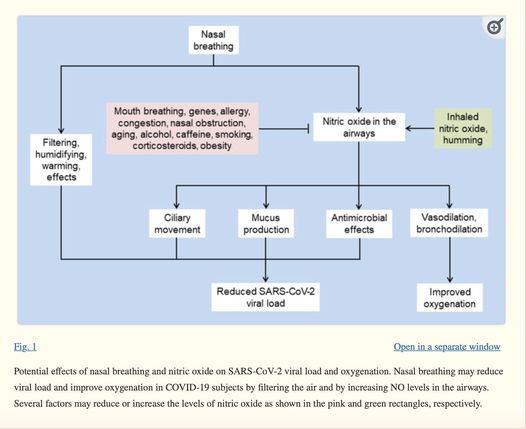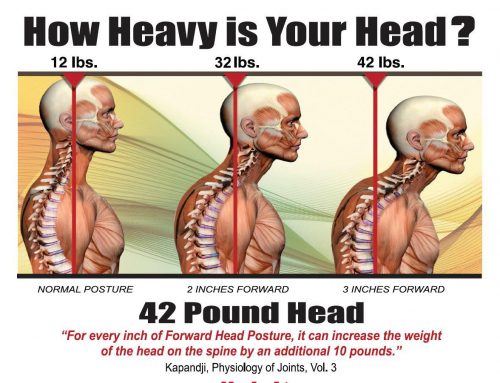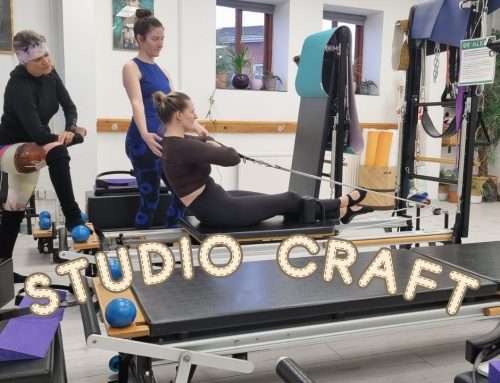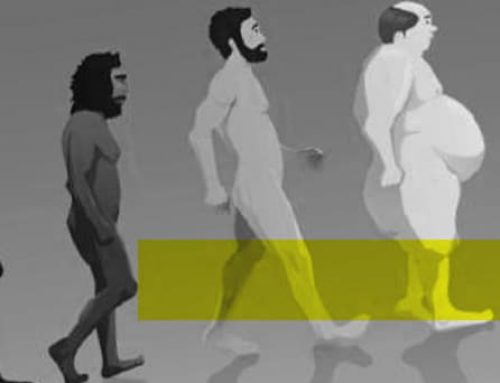Myth – Exercise alone will restore your posture! (But it won’t).
Everyone expects only one piece of the puzzle to work. We have to take a holistic view of the body, including breath work, hydration, sleep, mindset and nutrition. Breathing is an essential component of life and can both energize and relax you when performed properly and with intent. By paying attention to your breathing when you exercise you can attain the benefits of both working out and meditating.
It’s true: we cannot simply exercise our way out of a posture that we’ve developed over the years because:
- The tissue in the front of the body is locked in a shortened position. It needs to be released so the chest can open up and the shoulders can return to their proper position.
- The tissue in the back of the body is locked in a lengthened position and needs to be released and stimulated to prepare it for strengthening.
- So, hydrating and stimulating your fascia before performing carefully curated and targeted exercises is the optimal way to restore posture.
I know it can seem overwhelming, but here’s the good news: when you know what to do, it is simple, and I can teach you how to restore your posture and your health in no time. Now there is a constant argument in the movement and manual community that poor posture does not matter. This is my understanding after running studios and treating clients for over 30 years. Posture, breathwork and exercise have a three-way relationship. The more efficient the breath, the better the posture. Most of us have a faulty breathing pattern, which not only effects our posture but our health, immune system and ability to fight viruses.
A reverse breathing pattern can show with numerous symptoms in the body such as high blood pressure; establishing a good breathing pattern takes time. It is too easy to take breathing for granted as it’s a function that we don’t think about. Breathing is the forgotten power of life and the anchor for all the systems in the body. We all need to learn how to breathe correctly as up to 50% of the population is mouth breathing. You cannot say as long as I am breathing that it is fine, the same as you cannot say that as long as I am eating, I am fine. Our food effects every cell and system in the body and so does the breath. The average person breathes 20k- to 25 k breathes per day. Anyone who has seriously done their research on this subject will know the importance of breath and good health.
Mouth vs Nose Breathing
Most of us mouth breath. Mouth breathing is associated with high blood pressure, neurological conditions and as any physio will tell you a connection to chronic pain and injury. A ten day experiment was done at Stanford university to see the effects of mouth breathing versus nose breathing. The result was that the mouth breathers had sleep apnea, fatigue, poor concentration and felt miserable.
The key is to fix your airways. If we have a blocked plug in the house, we unblock it. Surgical intervention is usually not necessary. Firstly you need to look at your diet including sugar and carbohydrate intake. Then you can look at sleeping with mouth tape or doing netti pot.
Clients tell me that they have the best sleep ever once they have their mouths taped. This is about gently training your jaw to be closed at night and this should not be forced with duct tape or masking tape. You can measure your PH after nose breathing and notice the difference. Nose breathing produces nitric oxide. Nitric oxide is a free radical that protects us against bacteria, parasites influenzas and viruses including covid-19. Not to mention lowering blood pressure plus improving the immune system.
This discovery was made 15 years ago. A medical study was carried out on asthma patients in Stockholm, Sweden. The findings where that when we breathe through the mouth, there is no production of nitric oxide. When we breathe through the nose, there is production of nitric oxide into the lungs. The nasal mucosal cells make the nitric oxide that relaxes the smooth muscles including the bronchioles and trachea. This is turn makes the tubes wider so more oxygen can be carried increasing pulmonary circulation increasing blood flow to the lungs.
This information has been missing for the last two years in all media outlets. Yet it is common sense if you think about it.
Breathing and Posture
For starters, poor posture leads to inefficient and laboured breathing, creating tension in primary and secondary respiratory muscles like the levator scapulae (a skeletal muscle located in the back and side of the neck). It can easily be seen and felt in and around the neck and head area.
When breathing becomes very laboured, your shoulders rise as you inhale, because your primary respiratory muscles aren’t able to ventilate your body effectively. Behind the scenes, your posture has locked up important joints that now take tremendous force to move, making the act of breathing fatiguing. Clients show symptoms from headaches to TMJ to name but a few.
This locking may be the result of a poorly designed exercise program, too much exercise or not enough exercise to counteract the demands of any work inside or outside of the gym. This is why there is no such thing as a bad exercise but is such thing as a badly prescribed exercise.
A classic example that I see is the overuse of sit-ups or crunches that can shorten the abs into a position of exhalation that will increase the amount of effort needed to breathe normally. (This can be disastrous, for example, if you’re also a competitive runner, whose optimal exchange of oxygen and carbon dioxide can be the deciding factor between first and last place.)
Another obstacle affecting your posture: Prolonged sitting at work or commuting in your car or bus — not to mention in front of the TV – reduces the curve in the lumbar spine, leading to flat back posture and all the associated muscle imbalances that go along with it.
Yet, too many people who already have a flattened lumbar curve are going to group exercise and Pilates classes and being told to flatten their backs into the floor when they perform abdominal exercises! Instead of correcting problems created by their sedentary lifestyles, these ill-fitting exercise programs are making them worse. This is why you will never hear me say flatten, I will talk about keeping the sacrum heavy, the T12, legs of the belly connection plus the chin tuck.
Breathing and Exercise
Unfortunately, Most movement teachers have not been taught the basics laws of breathwork in conjunction with the body. It’s really quite simple once you know where to pay attention: movement in the spine and extremities. (See Table 1 below Paul chek image.)
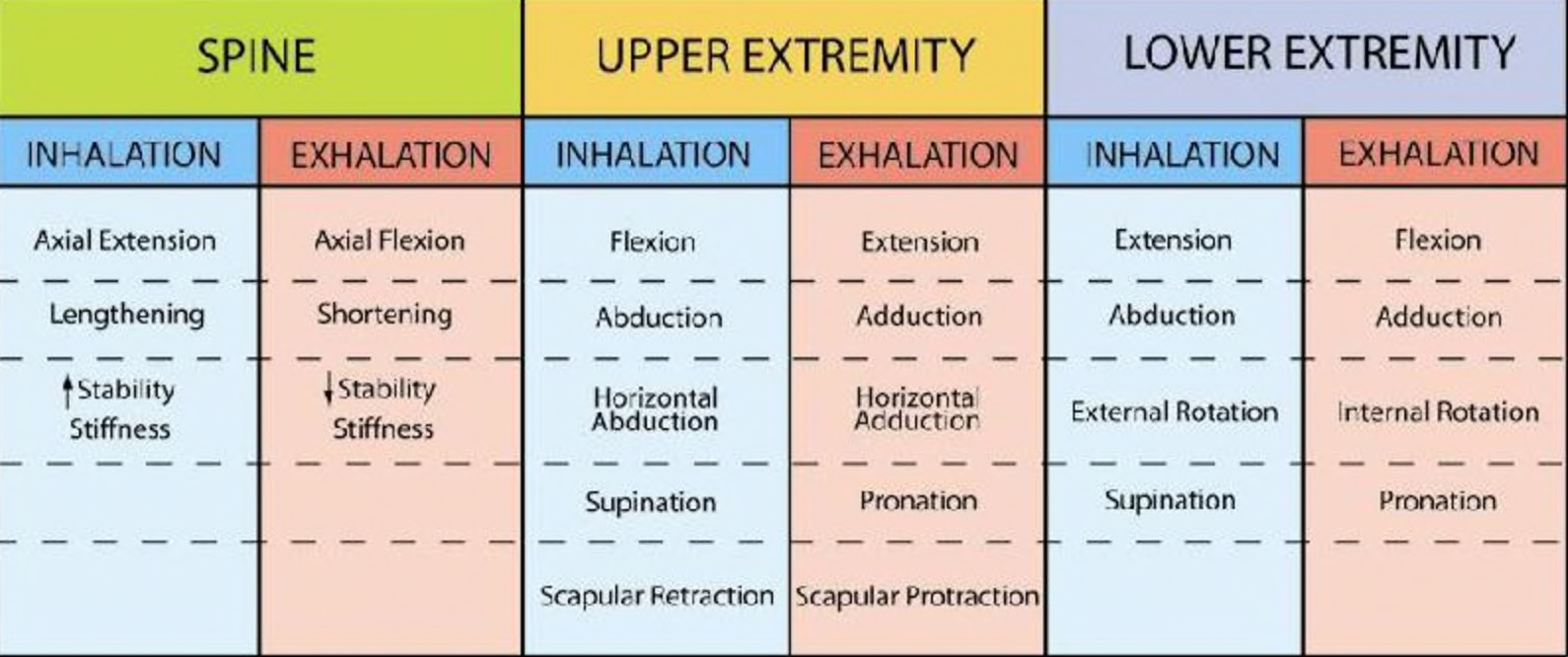
In short, if you are doing any exercise that moves you toward the foetal position, breathe out. Also breathe out on exercises where your spinal curvatures increase. Conversely, if the exercise moves your arms and legs away from the centre, or your spine lengthens, then breathe in. In a nutshell inhalation excites the extensors, exhalation take us towards the foetal position.
Thinking of it a different way, if you are getting taller as you’re doing a movement, breathe in. If you’re getting shorter, breathe out. With some exercises, the way you breathe is completely different depending on the grip you use, as this affects both the mechanics of the shoulder and how the spine moves in relation to the shoulder.
For example, when you’re doing a pronated grip chin-up (your palms are facing away from you), you’ll want to breathe in when you pull toward the bar. With a neutral grip (palms facing toward each other) or supinated grip (palms facing towards you), you will breathe out as you perform the pull-up.
However, if you breathe in as you’re pushing, you’re totally confusing your body, because inhalation excites the extensors. If you’re pushing and exciting the extensors, it’s like telling someone to stop and go at the same time, not a good recipe for successful athletic performance!
Dual functionality
There is too much focus on muscles rather than breathwork. Instead of focusing on the role of abdominals in spinal stabilization and thoracic positioning, try training the diaphragm first. There is still a prevailing paradigm that we can bully our ribs and spines around with external muscles. This may work short term, but it is not a good strategy. The breathing will be even more compromised if we are forcing abdominal pressure onto the diaphragm.
“Core stability, breathing, and posture are inextricably linked by pressure generated in the abdominal cavity by the movement of the diaphragm. This is called intra-abdominal pressure (IAP). Intra-abdominal pressure fluctuates through the breathing cycle.”
When breathing is fully functional, the diaphragm is better able to generate IAP – and better spinal stability.
This affects balance, as well as posture and movement. One small 2017 study explored the connection between diaphragm breathing training and static and dynamic balance. Thirteen participants practiced breathing exercises over eight weeks. Balance and breathing were assessed every week. Researchers found that each week, as breathing scores improved, participants showed fewer errors in single-leg balancing. This suggests that diaphragm breathing may help improve balance.
The Breathing Cure, Patrick McKeown
The respiratory system has a dual function. It also serves as a stabilizer system. The diaphragm is primarily a respiratory muscle and secondarily a stabilizer muscle. You can easily experience that in the gym. Choose any exercise, such as a deadlift, and start with a light load that you can lift at least 20 times while breathing. Then, increase the load to more than 60 percent or one that you cannot lift 20 times in a row. As you try to lift the load, you’ll stop breathing because, as the nervous system senses the threat to the spinal cord, the diaphragm switches to its stabilizer role since it is a massive muscle that connects to most of your ribs and helps to stabilize the body in the transverse plane.
So for exercises such as the deadlift, the breathing technique will vary depending on the weight being lifted. If the weight is light enough, you probably won’t need to hold your breath to help stabilize the spine. But, if the weight is heavy enough that you cannot breathe through the exercise, inhale at the start, hold your breath as you stand up and breathe out on the way down with pursed lips to keep pressure in the core. Now, you have a better understanding how breath, posture and exercise are uniquely related. Efficient breathing requires good posture. Good posture comes from effective exercise programs. In turn, breathing can facilitate exercise to enhance posture and optimize results and performance.
Try a meditative weight-lifting sessions all the time… It’s beautiful.
Bibliography
Could nasal nitric oxide help to mitigate the severity of COVID-19? –Published online 2020 May 6. doi: 10.1016/j.micinf.2020.05.002
Dr.Steven Lin
Dru Purohit
Paul Chek
James Nestor
Dr. Lou Ungaro
Patrick McKeown

